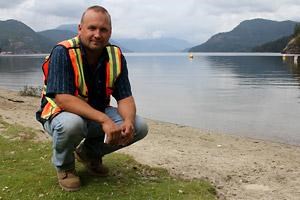by Kyle Wells [email protected] Geese may be one of the great symbols of Canada but they also storm our beaches and parks like an invading force in the summer, leaving an unsightly mess in their wake and treating the locals with aggression and disdain.
So says Paul Nassichuk, City of Powell River parks foreman, who is in the early stages of developing a plan for dealing with the seemingly ever increasing number of the migratory birds. Nassichuk said the problem with geese in the area, and the mess they leave behind, is getting progressively worse and he is worried about potential health and recreation implications.
“I just don’t remember them ever being as bad as they are now when I was young,” he said. “They flew away and we never had that problem. I think it’s the changing environment and the accessibility to food sources.”
Geese become the biggest problem during their moulting season in early August when they are essentially flightless and do very little more than eat and defecate, leaving large collections of droppings in the area.
Nassichuk said the city has also received reports of aggressive geese in parks, which he said is a concern for children. Around the airport geese can be a problem as well and airport employees already use bear bangers to scare them off the runway.
There are a number of approaches to the problem recommended by the Canadian Wildlife Service, a branch of Environment Canada, that Nassichuk is investigating. The basic first steps that have been recommended to the city are to prohibit the feeding of geese in parks and to encourage legal hunting of the geese as allowed by provincial hunting regulations.
The basic idea behind deterring geese from inhabiting parks is to make the habitat less attractive to the birds. Reducing the food source is the most important first step but beyond that other measures are available. Leaving long grass along shore lines, for instance, makes the birds wary to use it because it leaves an area where predators could lie in wait between them and their water source.
More serious steps include egg addling, which, after obtaining a permit, involves finding goose eggs and making it so they cannot hatch. The only problem with this method is that it does not help in the short term as geese can live up to 20 years, but it could work as a long-term solution, said Nassichuk. Another option is to, upon procurement of a special permit, kill the geese to lower their numbers.
Nassichuk stressed that the goose management plan is still in its early stages of development and that humane methods of dealing with the animals will be attempted first before any more serious measures are taken.
“I’m sure that this issue affects folks with children in the parks and in the playgrounds,” said Nassichuk, “it affects folks who are concerned about water quality, it affects folks who are golfers, it affects folks who want to use the outdoors and our open spaces. It’s nice to have wildlife...but there is coming a time, when hunting gets less and less and these populations are allowed to explode and we’re feeding them, something’s got to give.”
Any substantial management plan or proposed changes to bylaws will have to be approved by city council before being implemented.



